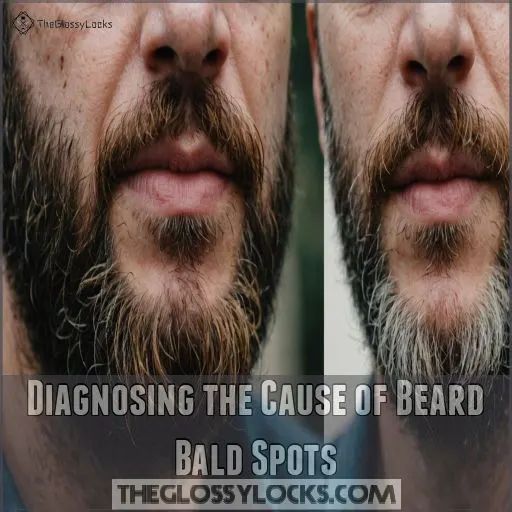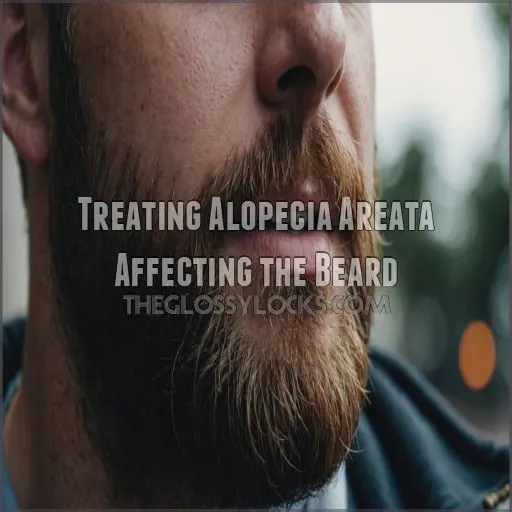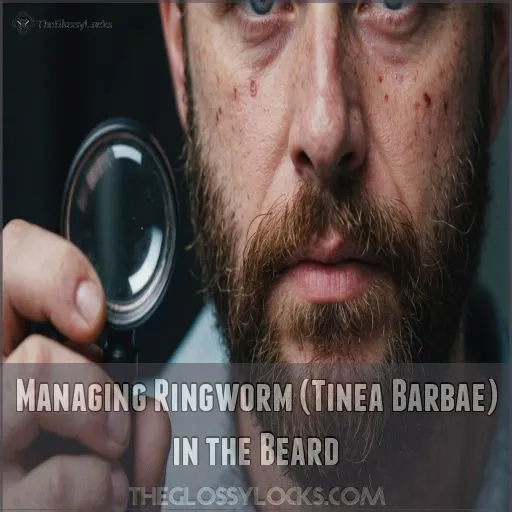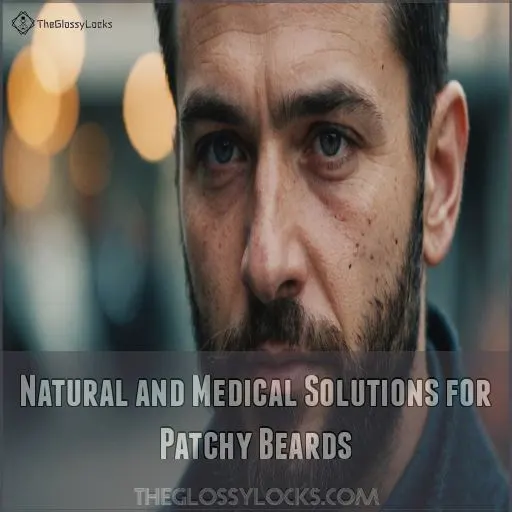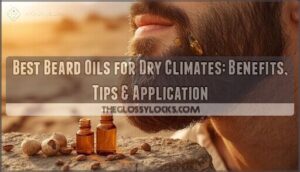This site is supported by our readers. We may earn a commission, at no cost to you, if you purchase through links.
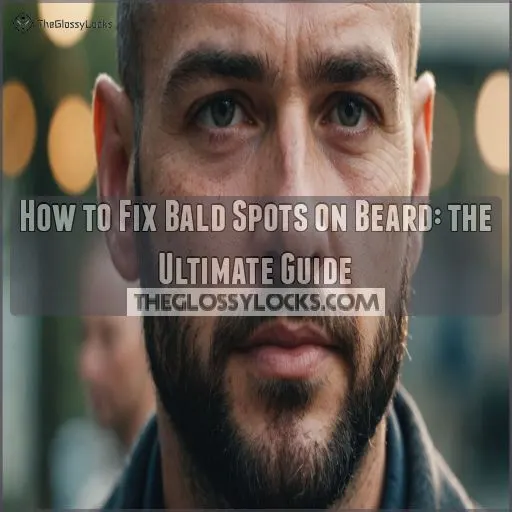
Let your beard grow freely to fill in patchy areas, even if it makes you feel like a mountain man.
Regular exercise keeps you fit but also boosts blood circulation, benefiting your beard too. Stress less—seriously, it’s not worth losing hair over.
Styling can work wonders; choose a beard style that plays to your strength. Treatments like minoxidil, or even transplants, offer options for persistent spots.
Ready to uncover more beard-enhancing secrets?
Table Of Contents
- Key Takeaways
- Understanding Patchy Beard Growth
- Diagnosing the Cause of Beard Bald Spots
- Treating Alopecia Areata Affecting the Beard
- Managing Ringworm (Tinea Barbae) in the Beard
- Natural and Medical Solutions for Patchy Beards
- Frequently Asked Questions (FAQs)
- How to prevent beard bald spots?
- Does castor oil help with the growth of a beard?
- How do I get rid of bald patches on my beard?
- How to get rid of patchy spots on a beard?
- Is there a way to fix bald spots in beard?
- Can a patchy beard be fixed?
- Do patchy beards fill in?
- Can a bald spot grow back?
- Can stress cause beard bald spots?
- Will diet changes improve beard baldness?
- How do genetics affect beard thickness?
- Are beard oils effective for bald patches?
- Does sleeping pattern influence beard growth?
- Conclusion
Key Takeaways
- Don’t stress – seriously, relax! Stress can be the sneaky culprit behind beard bald spots, often triggered by high stress levels
. Reducing stress might help your hair stay where it belongs. Try relaxing hobbies, deep breathing, or even a good nap – your beard (and mind) will thank you.
- Look at your plate, not just your face. A balanced diet packed with nutrients like zinc and iron can be the secret sauce for beard growth. Think of it as feeding your follicles a healthy, hair-loving buffet.
- Consider the science stuff! Minoxidil could give your patchy beard a boost, but patience is key. It’s not an overnight fix; think of it more like nurturing your very own Rome – it wasn’t built in a day, either.
- Styling isn’t just for mustaches! Use beard dyes and trimming techniques, including a well-maintained beard fade at home, to camouflage those pesky patches
. Get creative and think of it as styling your way to a seemingly fuller beard. Plus, experimenting with your look can be fun.
There were no grammatical errors to correct in the text.
Understanding Patchy Beard Growth
Whether you’re a bearded veteran or just starting your facial hair journey, dealing with patchy spots can be frustrating, especially when caused by sebum buildup issues sebum buildup causes
.
But don’t worry – understanding the common causes behind uneven beard growth is the first step to cultivating the full, lush look you desire.
Causes of Patchy Beards
Understanding why your beard grows in patchy can help you find the right solution.
Underlying causes may include hormonal imbalances, stress impacts, lifestyle habits, diet deficiencies, or medical conditions like alopecia areata barbae .
Getting to the root cause is key to achieving the full, even beard you desire.
The Role of Genetics and Hormones
While genetics and hormones play a significant role in determining the thickness and coverage of your beard.
The sensitivity of your hair follicles to the androgen hormone dihydrotestosterone (DHT) is the key factor.
Variations in genes like LNX1 can influence how your facial hair grows and appears, which is linked to the thickness and coverage of your beard.
Impact of Age and Lifestyle Factors
Your age, lifestyle, and daily habits all play a pivotal role in your beard’s growth.
As you mature, hormonal changes may slow down or speed up facial hair development.
Proper nutrition, exercise, and stress management can also nourish your follicles and optimize beard growth.
Allow time for your beard’s natural evolution, and make adjustments as needed to cultivate a full, lush look and nourish your follicles.
Diagnosing the Cause of Beard Bald Spots
If you’ve noticed bald spots or patchiness in your beard, a visit to your doctor can help pinpoint the cause.
From a quick physical exam to microscopic analysis of your hair samples, they can rule out any underlying infections or medical conditions that may be to blame.
Physical Examination by a Doctor
When seeing a doctor for patchy beard growth, they’ll perform a thorough physical examination, checking the skin and inspecting any affected areas up close.
They may also ask about your medical history to identify potential underlying causes, like autoimmune disorders or fungal infections.
The doctor’s keen eye can provide valuable insights to get to the root of your beard concerns, which is to identify the underlying causes.
Microscopic Analysis of Hair Samples
Ever wondered what your beard hair looks like under a microscope?
By taking a sample and examining it closely, your doctor can uncover clues about the cause of those pesky bald spots.
They may look for:
- Changes in hair shaft thickness
- Unusual hair growth patterns
- Signs of inflammation or infection
This microscopic analysis can help pinpoint the underlying issue and guide the best treatment plan for restoring your lush, healthy beard.
Ruling Out Infections and Other Conditions
A doctor will likely examine your skin and possibly perform a skin biopsy or blood tests to rule out infections, autoimmune conditions, or other underlying issues that could be causing your patchy beard.
Your medical history and any previous treatments can also provide valuable clues to pinpoint the root cause of your beard bald spots .
Treating Alopecia Areata Affecting the Beard
If alopecia areata is affecting your beard, there are treatment options available to help restore your hair growth.
Steroid creams, injections, or oral medications can be effective in addressing the autoimmune condition and encouraging new hair to emerge, helping to address the autoimmune condition.
Steroid Creams and Injections
steroid creams like clobetasol propionate and betamethasone valerate can be effective for treating beard alopecia areata .
Apply them sparingly, no more than twice daily for a week, as overuse can cause side effects like skin thinning.
For stubborn patches, your dermatologist may recommend targeted steroid injections, which can stimulate hair regrowth in up to 71% of cases and provide hair regrowth.
Oral Steroid Medications
If your beard alopecia proves stubborn, oral steroids may offer a solution.
These anti-inflammatory medications can rapidly regrow lost hair.
However, take care – higher doses risk side effects like folliculitis and skin thinning.
Work closely with your dermatologist to find the right dosage for your unique situation and goals.
Managing Ringworm (Tinea Barbae) in the Beard
If a reddish, scaly rash on your beard has you feeling like a medieval peasant, fear not.
Understanding how to manage ringworm, or tinea barbae, can help restore your follicular glory in no time.
Over-the-Counter Antifungal Treatments
Over-the-counter antifungal creams, gels, and powders can be your first line of defense against beard ringworm (tinea barbae).
Try terbinafine, clotrimazole, or miconazole, which are effective and easy to find.
Apply the medication twice daily for up to 2 weeks.
With diligence, you can clear up that pesky fungal infection and get your beard back on track using these treatments, which include terbinafine, clotrimazole, or miconazole.
Prescription Antifungal Medications
When over-the-counter options fail to clear up stubborn beard ringworm, you’ll likely need prescription antifungal medications to tackle the infection.
Oral terbinafine, itraconazole, or fluconazole are commonly prescribed and usually clear the condition in 4-6 weeks.
Follow your doctor’s instructions carefully, as some medications can interact with other drugs or have side effects. Additionally, be sure to take the medication as directed to ensure effective treatment of the infection.
Natural and Medical Solutions for Patchy Beards
If your beard is growing in patchy, don’t worry – there are plenty of natural and medical solutions to thicken and fill in those bald spots.
From proven treatments like minoxidil and microneedling to strategic styling tricks, we cover the best ways to get your beard looking full and healthy.
We will be discussing ways to achieve a full and healthy-looking beard.
Beard Growth Stimulants (Minoxidil)
Thinking of boosting your beard growth with minoxidil? This topical treatment can transform patchy beards, though side effects like dry skin might crop up when using patchy beard styles
.
Apply it twice daily, massaging gently for best absorption. Remember, results aren’t instant; patience is key.
Compare minoxidil with other treatments to find your perfect fit. After all, Rome wasn’t built in a day!
Microneedling to Enhance Circulation
Microneedling might just be the secret sauce to amp up your beard growth, especially for those dealing with alopecia areata treatment
.
By using a derma roller, you create tiny channels in your skin, boosting blood flow and collagen stimulation – think of it as waking up those lazy hair follicles.
While evidence is limited, some find it helpful.
Just remember, your skin might throw a tantrum with irritation or redness.
Beard Dying and Trimming Techniques
Every now and then, tackling a patchy beard can feel like solving a puzzle.
Start by using beard dye color to camouflage lighter hairs; keep it subtle to avoid going overboard.
Experiment with beard trimming styles for a fuller look, and use beard shaping tools to define lines.
Consistent beard maintenance tips help you ace that dapper appearance effortlessly.
Beard Implants and Hormonal Therapies
If you’re dreaming of a fuller beard without the patchy hiccups, beard implants could be your ticket.
This procedure involves transplanting hair from your scalp, offering long-lasting results.
Consider implant costs and potential hormonal therapies for boosting growth. But tread carefully—hormonal therapy can have side effects.
Talk to a specialist to make sure you get the best outcome and achieve that dashing look.
Frequently Asked Questions (FAQs)
How to prevent beard bald spots?
Battling beard bald spots?
Nip them in the bud with a two-pronged approach – tackle the root cause and nurture your facial follicles.
Arm yourself with the right tools and a little TLC, and you’ll be rocking a lush, full beard in no time.
Does castor oil help with the growth of a beard?
Castor oil mightn’t magically sprout new beard hairs, but it can nourish and strengthen existing ones, making your beard appear fuller and thicker over time.
Its moisturizing properties could also reduce irritation and dandruff.
How do I get rid of bald patches on my beard?
Getting rid of bald beard patches can feel like chasing shadows.
You can try antifungal treatments for infections, corticosteroids for alopecia barbae.
or embrace your style with smart grooming techniques to highlight stronger areas.
How to get rid of patchy spots on a beard?
Embrace your inner gardener: let your beard grow naturally or trim it to stubble to mask patchiness.
Brush daily and consider using beard balm or oils to style stubborn hairs.
A nutritious diet supports healthy growth.
Is there a way to fix bald spots in beard?
You can try using minoxidil to boost growth or a beard balm to style over bald spots.
If you need a permanent fix, consider a beard transplant.
Consult a dermatologist for personalized advice.
Can a patchy beard be fixed?
You can tackle a patchy beard by letting it grow, brushing daily, and maintaining a balanced diet rich in vitamins.
Consider using Minoxidil or beard balm to enhance coverage, embracing a stylish "combover" for facial hair.
Do patchy beards fill in?
Patchy beards can fill in over time as hair grows and covers gaps.
Genetics, hormones, and proper care like a balanced diet and grooming might help.
Patience and a bit of creativity with styling can work wonders.
Can a bald spot grow back?
Beard bald spots can grow back in many cases.
Conditions like alopecia barbae often see spontaneous regrowth.
Treatment options like corticosteroids can also help.
Be patient—it’s like waiting for grass to regrow.
Can stress cause beard bald spots?
Like a thief in the night, stress can sneak in and lead to bald spots on your beard.
It triggers conditions like alopecia areata which makes your body attack hair follicles, causing patchy hair loss.
Will diet changes improve beard baldness?
Boosting your diet with essential nutrients like zinc and iron might help tackle beard baldness, though results can vary.
You crave mastery, so observe and adjust—beard growth could be your next victory dance! .
How do genetics affect beard thickness?
Imagine inheriting a lush grandfatherly beard—
Genes are the primary influence on its thickness, dictating follicle sensitivity to hormones like DHT.
If your dad rocks a full beard, you’re likely to follow suit.
Are beard oils effective for bald patches?
Beard oils, while good for moisturizing and conditioning, aren’t proven to fix bald patches caused by alopecia or other conditions.
They keep the skin healthy but lack the clinical evidence for promoting hair regrowth in patches.
Does sleeping pattern influence beard growth?
You’ve got your nocturnal habits influencing beard growth!
Sleep deprivation can reduce beard growth by affecting hormone levels like growth hormone and dihydrotestosterone.
So, it’s not just beauty sleep—it’s beard sleep too!
Conclusion
Ready to reclaim your full, healthy beard? With the right mix of lifestyle changes, treatments, and styling techniques, you can kiss those pesky bald spots goodbye.
Whether it’s a genetic condition or a fungal infection, the solutions outlined here will help you fix bald spots on your beard and feel confident rocking your facial hair.
So what’re you waiting for? Get started on your journey to a fuller, more luscious beard today!


